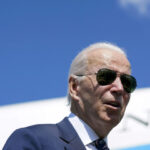By Michael Washburn
A recent poll finding that only 38 percent of Americans approve of the job that President Joe Biden is doing—down from 41 percent in December and 48 percent in July— is only the latest in a stream of bad news for the Democratic Party as November’s midterm elections draw near.
The 53 percent of Americans in the CNBC poll who said they disapproved cited Biden’s handling of the economy, along with the Ukraine crisis, as the primary reason.
In his recent public statements, Biden has tried to emphasize the good news and has called attention to a drop in unemployment figures during his administration, from 6.4 percent in January 2021 to 3.6 percent at present. But these figures appear to do little in distracting the public from an inflation rate that has driven the consumer price index (CPI) up 8.5 percent over the last year, resulting in the highest rate in four decades.
While the Ukraine conflict had had an undeniable impact on gas prices, and COVID-19 continues to disrupt global supply chains, particularly those emanating from places like the locked-down city of Shanghai, any efforts to place the blame on these external factors are unlikely to convince voters and lift the Democratic Party out of the hole into which it has dug itself, experts say. Over the last two years, Biden’s party, they say, has doggedly pursued fiscal policies that have driven up inflation.
Democrats have spent recklessly well beyond what a measured pandemic response might have called for, exacerbating supply-side problems with expansionist monetary policy, according to Ivan Pongracic, a professor of economics at Hillsdale College.
“The supply-side problems we’re currently experiencing, whether the pandemic-related supply-chain issues or the Ukraine-war-related hikes in commodity prices, most notably oil, are exacerbating factors, but the ‘original sin’ is the massive run-up in the money supply by the Federal Reserve in the past two years,” Pongracic said.
The Fed’s Approach
The Federal Reserve has been busily injecting new money into the economy by buying Treasury bonds from banks. This has the effect of replacing the bonds held by the banks with new money, and steadily increasing cash reserves for the banks to loan out, Pongracic noted. The aim here has been to offset the higher demand for loanable funds, for which the pandemic is partly responsible, with a greater supply of loanable cash, and thereby to keep interest rates under control.
The M2 measure of money supply—the Fed’s broadest measure of money in the economy— has risen by 40 percent in the last two years, an increase that Pongracic calls “astounding.”
“The Fed monetized a large amount of that debt to keep the interest rates from rising, thinking they would be able to mop it all up quickly as the pandemic subsided. Alas, Biden’s massive spending plans made that impossible, and the Fed continued its accommodative policies for almost certainly much longer than they originally planned,” Pongracic said.
A massive, indeed unprecedented, public spending program, such as the $1.9 trillion American Rescue Plan, which Biden signed into law in March 2021 is not the ideal context for easing the demand for loanable funds.
The administration has effectively monetized the government’s debt, replacing the government bonds held in the banks with newly printed money. The final outcome of this tendency, Pongracic said, is exactly the same scenario we would have if Congress controlled the Fed and made the decision to fund its own deficit spending by printing new money rather than by issuing bonds.
“This is always the primary source of inflation, which is why, in the entire Western world, central banks have been made independent and designed to focus first and foremost on price stability,” or low inflation, Pongracic said. With the advent of the pandemic, banks turned away from their traditional role as guardians of price stability and decided to make helping governments fund massive lockdowns a higher priority.
Vance Ginn, chief economist at the Texas Public Policy Foundation who served as associate director for economic policy at the White House’s Office of Management and Budget from 2019 to 2020, affirms that printing money at such levels is conducive to an economy where too much cash chases too few goods and one that is unlikely to escape runaway inflation. The consequences are not lost on voters.
“The number one thing on people’s minds is inflation, and especially the 8.5 percent increase in the CPI over the last year. That’s the highest since December 1981,” Ginn said.
A full generation of Americans who are not old enough to remember the 1970s have never seen inflation like this in their lives, Ginn noted, and those who are old enough have decidedly negative reactions. Whatever a voter’s age, it doesn’t look promising for the Democratic Party.
“People who witnessed this kind of inflation back then are saying, ‘Not this again!’ It’s a challenge to continue to pay for higher food prices, prices at the pump. Everywhere you look, prices are going up,” Ginn said.
The sharp inflation is all the harder to absorb in an economy where, notwithstanding Biden’s recent optimistic statements, three million people are still out of the labor force and fewer are employed than in February 2020, in the days before the lockdowns and recession, Ginn observed.
“There’s so much uncertainty, people just aren’t sure about the future, and that goes against the party that’s in power. President Biden’s poll ratings continue to be pretty low, the lowest of his tenure so far, and that’s indicative of the economy at large,” he added.
Ginn doubts that Biden and fellow Democrats will be able to sell the public on the notion that the negative trends are the passing result of the Ukraine conflict and other external forces, rather than the consequences of their own policies. Oil prices had been going up rapidly long before Russia invaded Ukraine on Feb. 24. Meanwhile, the Biden administration hampered domestic production by shutting down the Keystone XL pipeline, and the growing tendency of the Securities and Exchange Commission to base financial regulations on “ESG” principles—Environmental, Social, and Governance—has helped shut off the flow of capital to domestic oil and gas producers, Ginn observed.
“This contributes to a lack of supply, and therefore much higher prices. Right now, we’re all over the place with policies that are driving up infrastructure pressures rather than help deflate them,” he said.
The Way Forward
While economic prospects for the next few years are not hopeless, reversing the decline that expansionist monetary policies and overregulation have brought about will not be easy and may involve some politically unpopular measures. But Democrats might consider the judgment that voters may render at the polls in a few months if they are unwilling or unable to change course.
Bringing inflation under control will require the Federal Reserve to begin raising interest rates more rapidly than Fed officials proposed to do at their Federal Open Market Committee meeting last month, Pongracic said. To do so will run the risk of popping the “bubbles” that have developed in certain sectors of the U.S. economy, namely the real estate markets, which Pongracic called vastly overvalued at present. Such a change of course may also help usher in a recession.
“The Fed is aiming for a ‘soft landing’ [taming inflation without causing a recession], as they refer to it, but in my opinion, they’ve gone much too far to make that possible. Drastic actions will be necessary, and I personally do not feel very confident that the current leadership of the Fed has what it takes to make those difficult decisions,” he said.
In Pongracic’s view, a likelier outcome is that Fed officials will make promises but in the end will prove unwilling to practice the frugality that will return inflation to the Fed’s target of two percent. The “invisible tax” of high inflation will fall on the shoulders of all Americans, fostering disarray and scenes reminiscent of the stagnant economy and long gas lines of the 1970s.
In Ginn’s view, overregulation continues to be a serious issue. The Trump administration’s Tax Cuts and Jobs Act of 2017 was a step in the right direction and signaled recognition, at least at some levels of government, that taxing corporations exorbitantly is not a solution because corporations are not surrogates to which government can simply shift the burden of taxation, but are made up of groups of individuals. High corporate taxes mean lower wages and fewer jobs, and the effects on society at large are more than evident.
“The lower we can keep the corporate rate, the more competitive we will be on a global playing field, to have domestic production of energy that will allow us to have more competitive growth,” he said.
While Democratic Party rhetoric may emphasize helping the poorest members of society, it is well to look at who suffers the most from runaway inflation, according to Ginn.
“Progressives say they’re trying to help the lower-income people, but their policies hurt those people that most. Too much regulation, which progressives argue is for the betterment of the people, hit those with lower incomes the hardest, which is an unfair situation,” he said.
While the wealthy will find ways around measures like the so-called billionaire tax, they will ultimately result in less capital invested in the economy. This translates to fewer jobs and lower wages, Ginn said.
“There should be opportunities for everyone to move up the income ladder, and too often, by imposing more regulation, you actually reduce the chances of those on the lower rungs,” he said.






